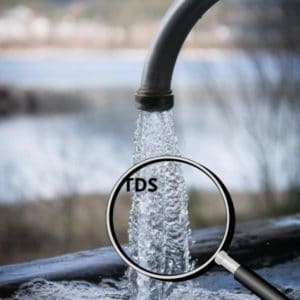Effective Ways of Removing TDS From Drinking Water
According to some water experts, 50-150 PPM (Parts Per Million) TDS is safe for human consumption, and anything exceeding this range is harmful. Here are the most common treatment options to reduce TDS from drinking water:
Reverse Osmosis
The RO system eliminates 95 to 99 percent of the total dissolved solids (TDS). Therefore, reverse osmosis systems are ideal for converting salt water into drinking water. They reduce TDS and produce clean and healthy water with a pleasant taste.
Reverse osmosis filtration works on the principle of osmosis. It’s a multistep process. First, the reverse osmosis system pushes water through a semipermeable membrane. This membrane has microscopic pores that do not let TDS, natural minerals, and inorganic salts pass through it.
Then this reverse osmosis water is passed through a very fine filter to complete the filtering process. The reverse osmosis system is the cheapest and most used water purification method available.
Distillation
Distillation is another effective way of purifying water and removing all the dissolved solids. In this process, the water having more than acceptable TDS levels is heated vigorously until it changes into vapors. Then the system cools these vapors and changes them into pure water.
The boiling point of water is different from the dissolved solids and harmful contaminants. So, they do not convert into vapors; thus, it improves the water quality. But compared to an RO system, water distiller systems are expensive.
Deionization
As its name suggests, the Deionization process includes the exchange of ions from water to any other chemical. Water is carried over a positively and negatively electrode in this procedure. Thanks to the ion-selective walls, positive ions can split from the water and travel towards the negatively charged electrode.
The final product is highly purified deionized water. However, to remove non-ionic organic pollutants, you need to put the water through a reverse osmosis system first.
What Are TDS In Water?
Total dissolved solids are the dissolved ions found in all non-pure sources of water. They are mainly inorganic salts like magnesium, potassium, sodium, chlorides, sulfates, etc. They may also have lead, mercury, arsenic, etc.
Any impurity is considered to be TDS. It, generally, includes naturally occurring minerals and dissolved solids present in water.
The presence of total dissolved solids in water is not always a terrible sign. Some are beneficial, while others are toxic. The most popular forms are:
Minerals: Minerals including magnesium, calcium, and potassium are naturally found in water. Small quantities of minerals are dispersed in water when water in streams, waterways, and lakes comes into touch with mineral-rich rocks. Minerals improve water’s flavor and add other benefits to your water.
Salts: Freshwater can contain small minor quantities of salts. Human activities, such as de-icing roads, fertilizers and water softener usage, and even sewer pollution, may alter salt levels.
Dissolved Metals: Pollution is the primary source of soluble metals in water. Metals may seep into drinking water from toxic waste and human impacts such as digging or mining. Small quantities of metals can be found in rocks and soil, and some metallic pipelines can also increase the soluble metal amount in the liquid.
When a TDS meter measures the amount of TDS, it does not differentiate between good and harmful ions. Therefore, a low TDS level does not always mean high water quality and vice versa. For example, bottled mineral water has high levels of TDS, i.e.250, but it is safe to drink.
Sources of TDS in Water
Total dissolved solids (TDS) can arise from various places. Sewer, water filtration chemicals, fertilizer waste, and industrial discharges may all leak into the water. TDS can also be found in natural sources such as soils and rocks.
TDS may be carried by urban runoff or rainfall flowing through urban environments, and even the pipelines and infrastructure supplies used to transport water to a house can be a TDS source.
It should be clear that TDS isn’t always a terrible thing. TDS-like healthy minerals can be found in calcium reserves and mineral springs. Salts, a typical kind of TDS, can enter drinking water due to saltwater intrusion or even de-icing agents used on city roads.

Dangers Of TDS
In water, high TDS levels may cause various diseases like nausea, rashes, dizziness, and many more. Drinking water with a high TDS level for an extended period brings in different chemicals, leading to severe health problems.
Liver and kidney failures, cancer, nervous system diseases are the most reported diseases caused by high TDS levels in the water.
High TDS levels can change the taste and odor of water. The maximum acceptable amount has been imposed at 500 milligrams per liter (mg/L) by the US Environmental Protection Agency.
EPA considers them as secondary contaminants. Low TDS water does not pose a health risk, and it only changes the taste.
Does Water Filter Remove TDS?
Yes, a water filter can remove TDS. A water filter can physically remove large solids and particles. To remove some nanoparticles, you need to use thinner membranes in the water filter.
Reverse osmosis filters and water ionizers can come in handy in case of high TDS due to their thin filter membranes. Although they are pretty costly, you should only use them if your water TDS level is above the acceptable limit and harms your health.
Moreover, as you already know that there are different TDS contaminants, so some of the particles can pass through filters, and you will need to filter them twice.
Which Water Filters Remove TDS?
Let’s have a look at the water filters which are effectively known to reduce high TDS from water:
Water Dispenser And Pitcher
A water dispenser or pitcher is known to remove TDS by passing the water through a relatively simple purification method. The best part about the water pitcher is its size and portability. It is best for those adults or families who live in a rental home or apartment.
It can filter out hard organic particles and remove the taste and odor caused by these particles. A water dispenser and pitcher do not deduct TDS fully but can bring it down to a safe level for drinking.
Under Sink Water Filter
This might be the most expensive option on this list, but it is the most effective filter to remove TDS from water. You would have to face some complexities with this filter, but it can remove around 99% of TDS from water.
A semipermeable membrane thickness of 0.0001 microns is the best technique to keep TDS out of filtered water. The only negative effect of under sink filters is that they do not filter the water supply of all the house water. For that purpose, you need the best whole house RO filter.

Water Ionizer
It is another TDS water filter that will be light on your pocket and heavy on dissolved particles. A water ionizer uses the electrolysis process to remove the TDS from water. This electrolysis process doesn’t remove the TDS, but instead, it separates it from the water, which can be filtered out afterward.
Before passing the water through the water ionizer, most water ionizers will pass it through a pre-filter for highly pure water.
FAQ’s on How to Remove TDS From Water
How do I know if my house water is contaminated with TDS?
Various TDS meters are available online to measure TDS. However, the most prominent indicator of TDS presence in water is the change of taste and odor.
TDS can make your water taste salty and powdery if some minerals are also present. Furthermore, the odor of TDS-contaminated water isn’t a strong one, but it can be easily detected.
Does water softener remove TDS?
No, TDS is not removed by water softeners. Water softeners only remove hard water minerals from the water.
Does Boiling Water Remove TDS?
The TDS in your tap water is not affected by boiling the water. Toxic metals in the water can not evaporate. Thus they might remain in your drinking water, leaving it unsafe for drinking. TDS can only be efficiently removed by using an RO filter.
Conclusion
Drinking clean and pure water is essential for maintaining human health. Therefore, you should regularly check your water for contaminants and employ water treatment methods to remove these. According to EPA, TDS is a secondary contaminant. You should measure it periodically as well.
If the TDS reading is low, your water will have a flat taste and if the TDS reading is high, it will be bitter or metallic. High levels are alarming as they are harmful to us. The maximum acceptable TDS level is 500 ppm. If your water has high PPM then you should learn how to remove TDS from water.
